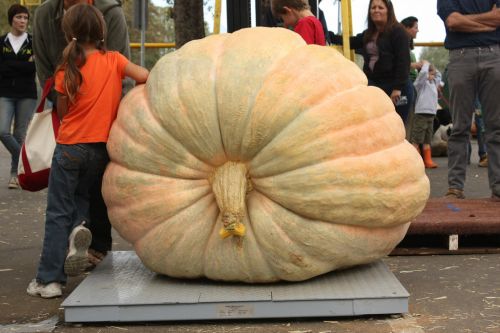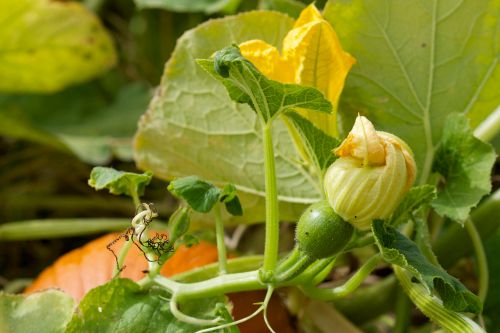
Remember the first time you laid eyes on a giant pumpkin? It may have been at a fair or a farm, but you were in awe and secretly you’ve always wanted to grow one of your own.
This could be your year. The summer that a 2,000 behemoth of a pumpkin — complete with bragging rights — sits proudly in your vegetable garden. This year, it’ll be your pumpkin that makes eyes pop and mouths drop.
I’m bringing this up in the dead of winter because this is the time to purchase seeds and start planning and gathering secret information on growing record-breaking pumpkins. (By the way, if a giant pumpkin contest is in your future, consider having a crane and fork lift at the ready.)
Giant Genetics
The truth is that the most important part of the monster-squash-equation is in the genes. Planting pumpkin seeds that have a genetic predisposition to hugeness is key. The pumpkin variety that dominates as far as world records go is ‘Dill’s Atlantic Giant‘. So start is with Atlantic Giant pumpkin seeds either from a seed catalog or a local nursery.
After that, it’s a savvy grower’s game. Seasoned pumpkin growers have some well-guarded secrets and your job is to uncover those secrets. Try bribes.
Start Early and Prepare the Bed
In order to take full advantage of the growing season, it’s best to start your pumpkin seeds indoors a few weeks before the last frost date in your area. While your seeds are germinating inside, you can prepare the pumpkin bed outside.
Choose a spot that receives 8-10 hours of full sun and add as much compost and composted manure that you can to the soil in the bed. Monstrous veggies need big nutrients, so add as much organic matter as possible to the bed. An ideal soil pH for pumpkins is between 6.5 – 6.8.
Seasoned Giant Pumpkin Growers Tip: Don’t wait until late winter or early spring to prepare you pumpkin bed. Prepare the space in the fall — months before you plant. In this case, you can pile compost and composted manure up into the bed. Cover it with straw or wet newspaper (6 sheets thick). Let it compost in place all winter long.
Pollination — Making Baby Pumpkins
Plant your pumpkin seedlings into the prepared bed and water them regularly for about 8-10 weeks. When the plants begin blooming, you’ll notice that there are both female flowers and male flowers. The female flowers are the ones with the little “pumpkin” behind the blossom (not truly a pumpkin yet, but could be if it is pollinated).
The sooner a pumpkin forms and begins to grow, the longer it has to become the giant of your dreams, so you don’t want to waste one day by waiting for natural pollination to occur. These beefy guys can gain up to 25 pounds a day!
Your best bet is to hand-pollinate the flowers yourself. Early one the morning, choose an open male flower. Pick it off the vine and pull off the outer petals. What you’ll have left is the stamen with fresh pollen on it. Find an open female flower and lightly brush the inside of the female flower with the stamen of the male flower.
Choose the Contenders
When your pumpkins start to form, look for the one that’s very round, long, and growing the quickest. You’ll know which one this is by measuring around the largest part of each pumpkin. This will be your chosen, giant pumpkin because it will be the one that become the biggest in your pumpkin patch. Growers often keep the biggest two or three just in case something goes wrong along the way.
You’ll need to decide which to keep (only a few at most) and cut off the rest. It’s a brutal, but necessary task if you’re going for a prize-sized pumpkin. While the pumpkins are growing, keep the end of the vines pruned to about 8-10 feet beyond the pumpkins. This way the growth energy is spent on the pumpkin size as opposed to vine length.
Seasoned Giant Pumpkin Growers Tip: The position of the vines as they are related to the pumpkin’s stem is very important. As it gets heavier and heavier, if the stem is at the wrong angle, the pumpkin will snap off. Ideally, you want the stem to be perpendicular to the vine it’s growing on.
Feed the Giant
Fertilize your pumpkins once or twice a week, but avoid over-fertilizing them. If pumpkins are fertilized too much, it’s possible that they could pull away from the vines early and in effect – blow up!
Once the pumpkins grow to 5-10 pounds, be sure to place a large board (like plywood) underneath the pumpkins so they won’t rot on the side that’s against the soil. At the end of the growing season, you may find that you have a contender for a “largest pumpkin” contest. Look for an event near you like the Safeway World Championship Pumpkin Weigh-Off in Half Moon Bay, California.



















Comments
Log in or create an account to post a comment.
Sign up Log in